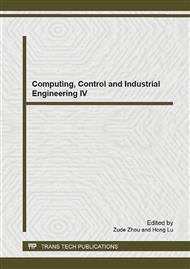p.184
p.188
p.193
p.199
p.205
p.214
p.218
p.222
p.228
A Design of Continuous and Universal In Situ Remediation Appliance of Soil Combines
Abstract:
Continuous and universal in-situ remediation appliance of soil combines taking soil, transmission and restoration of soil, which can achieve the in-situ remediation continuously and avoid the drawback of massive labor power and material resources using domestic soil ex-situ remediation device. The appliance supports many kinds of soil remediation technology, realizing the function of universal technology. And as for the area with serious pollution, various technology combinations can be selected to extend its function. The motion of specific remediation device in the appliance utilizes the single-chip controlling technology, controlling the remediation time interval of different technology. The program selection with various remediation technologies can be finished with buttons. Single-chip controlling system responds quickly, runs stably and precisely controls the remediation device.
Info:
Periodical:
Pages:
205-213
Citation:
Online since:
October 2013
Authors:
Keywords:
Price:
Сopyright:
© 2013 Trans Tech Publications Ltd. All Rights Reserved
Share:
Citation:


